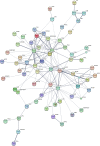iTRAQ-Based Proteomics Reveals Novel Biomarkers for Idiopathic Pulmonary Fibrosis
- PMID: 28122020
- PMCID: PMC5266322
- DOI: 10.1371/journal.pone.0170741
iTRAQ-Based Proteomics Reveals Novel Biomarkers for Idiopathic Pulmonary Fibrosis
Abstract
Idiopathic pulmonary fibrosis (IPF) is a gradual lung disease with a survival of less than 5 years post-diagnosis for most patients. Poor molecular description of IPF has led to unsatisfactory interpretation of the pathogenesis of this disease, resulting in the lack of successful treatments. The objective of this study was to discover novel noninvasive biomarkers for the diagnosis of IPF. We employed a coupled isobaric tag for relative and absolute quantitation (iTRAQ)-liquid chromatography-tandem mass spectrometry (LC-MS/MS) approach to examine protein expression in patients with IPF. A total of 97 differentially expressed proteins (38 upregulated proteins and 59 downregulated proteins) were identified in the serum of IPF patients. Using String software, a regulatory network containing 87 nodes and 244 edges was built, and the functional enrichment showed that differentially expressed proteins were predominantly involved in protein activation cascade, regulation of response to wounding and extracellular components. A set of three most significantly upregulated proteins (HBB, CRP and SERPINA1) and four most significantly downregulated proteins (APOA2, AHSG, KNG1 and AMBP) were selected for validation in an independent cohort of IPF and other lung diseases using ELISA test. The results confirmed the iTRAQ profiling results and AHSG, AMBP, CRP and KNG1 were found as specific IPF biomarkers. ROC analysis indicated the diagnosis potential of the validated biomarkers. The findings of this study will contribute in understanding the pathogenesis of IPF and facilitate the development of therapeutic targets.
Conflict of interest statement
The authors have declared that no competing interests exist.
Figures





Similar articles
-
Application of Isobaric Tags for Relative and Absolute Quantification (iTRAQ) Coupled with Two-Dimensional Liquid Chromatography/Tandem Mass Spectrometry in Quantitative Proteomic Analysis for Discovery of Serum Biomarkers for Idiopathic Pulmonary Fibrosis.Med Sci Monit. 2018 Jun 17;24:4146-4153. doi: 10.12659/MSM.908702. Med Sci Monit. 2018. PMID: 29909421 Free PMC article.
-
[Screening on serum biomarkers in idiopathic pulmonary fibrosis patients by proteomics technology].Zhonghua Liu Xing Bing Xue Za Zhi. 2018 Aug 10;39(8):1117-1120. doi: 10.3760/cma.j.issn.0254-6450.2018.08.020. Zhonghua Liu Xing Bing Xue Za Zhi. 2018. PMID: 30180439 Chinese.
-
Proteomic analysis of bronchoalveolar lavage fluid samples obtained from West Highland White Terriers with idiopathic pulmonary fibrosis, dogs with chronic bronchitis, and healthy dogs.Am J Vet Res. 2013 Jan;74(1):148-54. doi: 10.2460/ajvr.74.1.148. Am J Vet Res. 2013. PMID: 23270360
-
PROFILEing idiopathic pulmonary fibrosis: rethinking biomarker discovery.Eur Respir Rev. 2013 Jun 1;22(128):148-52. doi: 10.1183/09059180.00000913. Eur Respir Rev. 2013. PMID: 23728868 Free PMC article. Review.
-
Molecular classification of idiopathic pulmonary fibrosis: personalized medicine, genetics and biomarkers.Respirology. 2015 Oct;20(7):1010-22. doi: 10.1111/resp.12569. Epub 2015 Jun 24. Respirology. 2015. PMID: 26109466 Review.
Cited by
-
HSP90 Inhibition and Modulation of the Proteome: Therapeutical Implications for Idiopathic Pulmonary Fibrosis (IPF).Int J Mol Sci. 2020 Jul 25;21(15):5286. doi: 10.3390/ijms21155286. Int J Mol Sci. 2020. PMID: 32722485 Free PMC article. Review.
-
Proteomic Analysis Reveals Differential Expression Profiles in Idiopathic Pulmonary Fibrosis Cell Lines.Int J Mol Sci. 2022 May 1;23(9):5032. doi: 10.3390/ijms23095032. Int J Mol Sci. 2022. PMID: 35563422 Free PMC article.
-
Quantitative proteomic characterization of lung tissue in idiopathic pulmonary fibrosis.Clin Proteomics. 2019 Feb 6;16:6. doi: 10.1186/s12014-019-9226-4. eCollection 2019. Clin Proteomics. 2019. PMID: 30774578 Free PMC article.
-
Flt1 produced by lung endothelial cells impairs ATII cell transdifferentiation and repair in pulmonary fibrosis.Cell Death Dis. 2023 Jul 15;14(7):437. doi: 10.1038/s41419-023-05962-2. Cell Death Dis. 2023. PMID: 37454154 Free PMC article.
-
Isobaric tags for relative and absolute quantitation‑based proteomics reveals potential novel biomarkers for the early diagnosis of acute myocardial infarction within 3 h.Int J Mol Med. 2019 May;43(5):1991-2004. doi: 10.3892/ijmm.2019.4137. Epub 2019 Mar 19. Int J Mol Med. 2019. PMID: 30896787 Free PMC article.
References
-
- Davies HR, Richeldi L. Idiopathic Pulmonary Fibrosis. American Journal of Respiratory Medicine. 2002;1(3):211–24. - PubMed
Publication types
MeSH terms
Substances
LinkOut - more resources
Full Text Sources
Other Literature Sources
Research Materials
Miscellaneous

